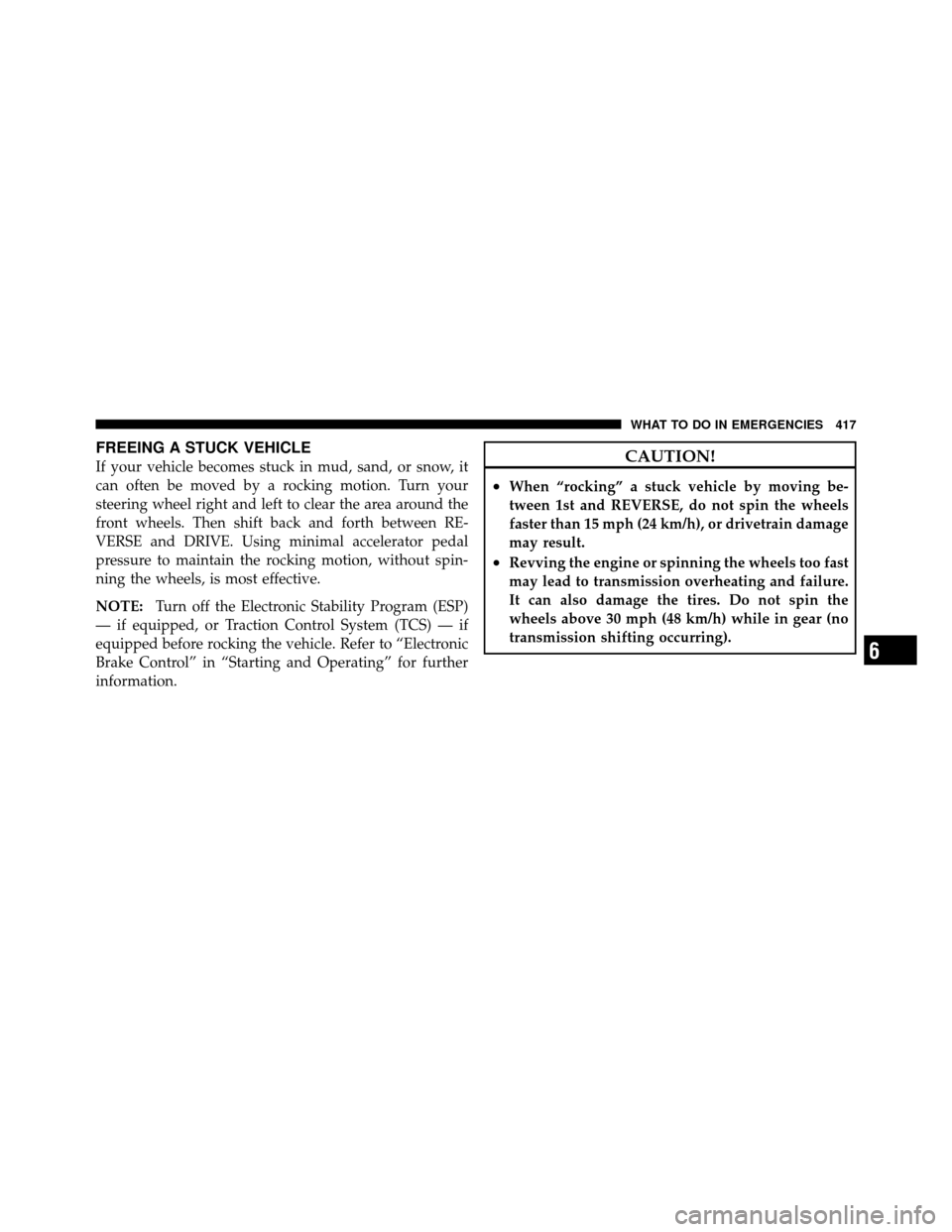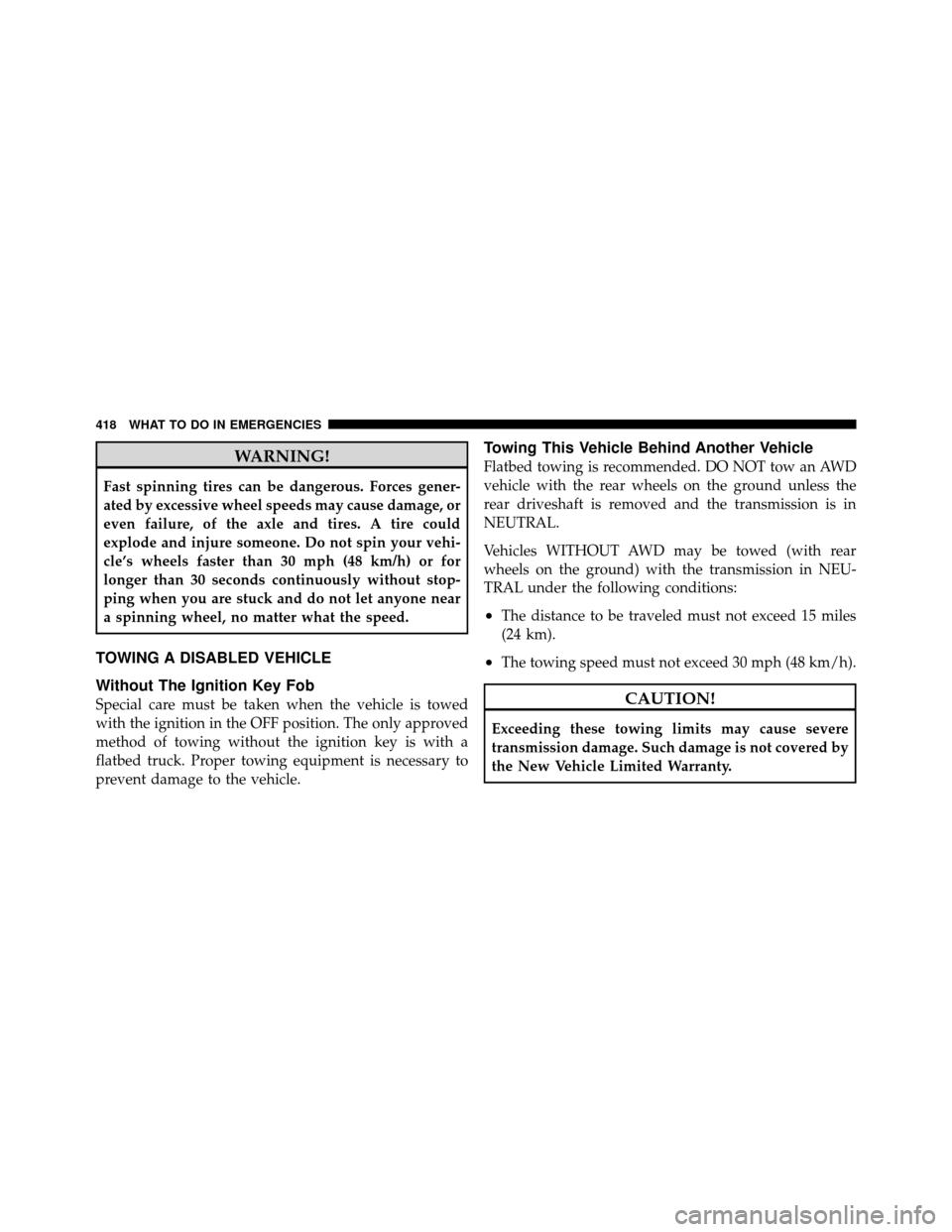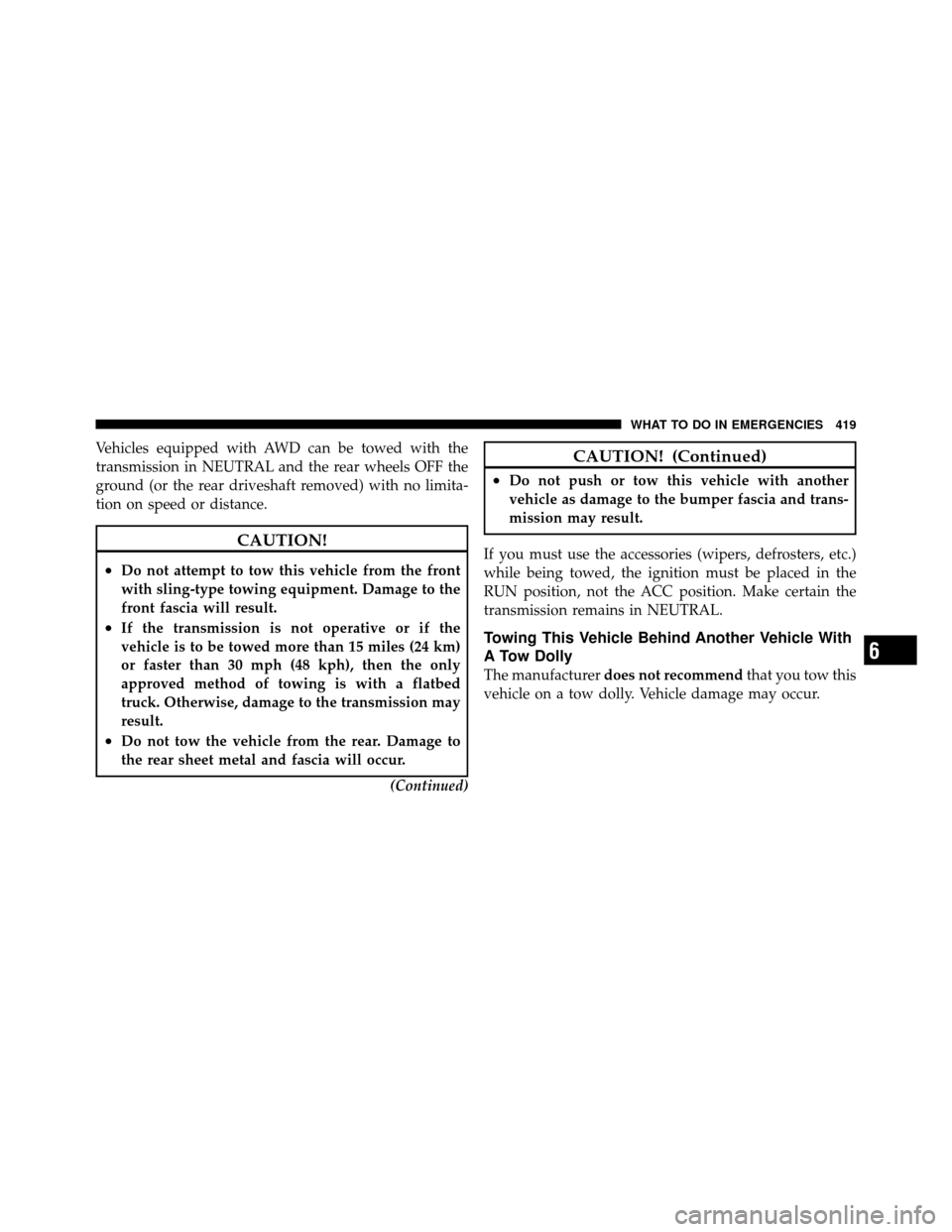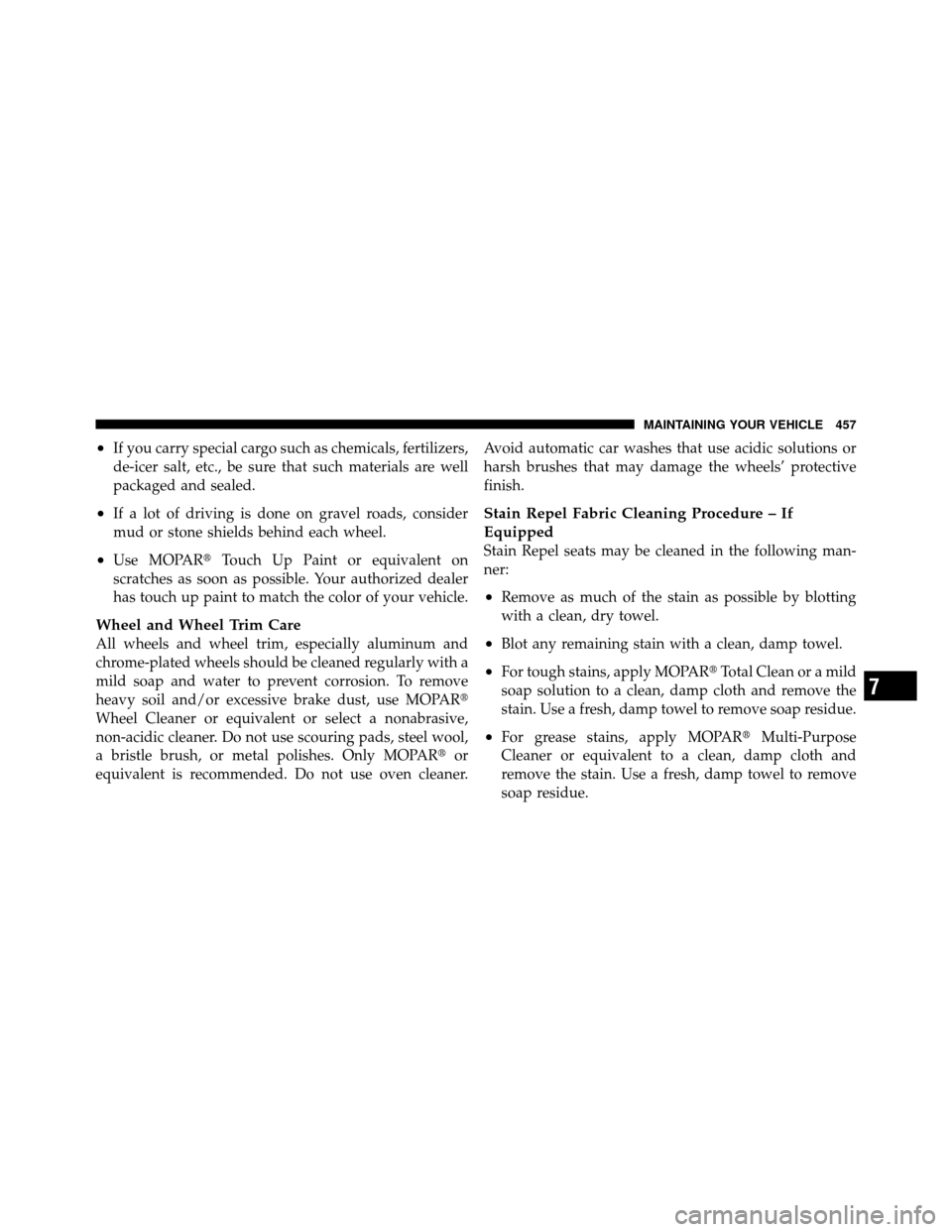Page 418 of 538

FREEING A STUCK VEHICLE
If your vehicle becomes stuck in mud, sand, or snow, it
can often be moved by a rocking motion. Turn your
steering wheel right and left to clear the area around the
front wheels. Then shift back and forth between RE-
VERSE and DRIVE. Using minimal accelerator pedal
pressure to maintain the rocking motion, without spin-
ning the wheels, is most effective.
NOTE:Turn off the Electronic Stability Program (ESP)
— if equipped, or Traction Control System (TCS) — if
equipped before rocking the vehicle. Refer to “Electronic
Brake Control” in “Starting and Operating” for further
information.CAUTION!
•When “rocking” a stuck vehicle by moving be-
tween 1st and REVERSE, do not spin the wheels
faster than 15 mph (24 km/h), or drivetrain damage
may result.
•Revving the engine or spinning the wheels too fast
may lead to transmission overheating and failure.
It can also damage the tires. Do not spin the
wheels above 30 mph (48 km/h) while in gear (no
transmission shifting occurring).
6
WHAT TO DO IN EMERGENCIES 417
Page 419 of 538

WARNING!
Fast spinning tires can be dangerous. Forces gener-
ated by excessive wheel speeds may cause damage, or
even failure, of the axle and tires. A tire could
explode and injure someone. Do not spin your vehi-
cle’s wheels faster than 30 mph (48 km/h) or for
longer than 30 seconds continuously without stop-
ping when you are stuck and do not let anyone near
a spinning wheel, no matter what the speed.
TOWING A DISABLED VEHICLE
Without The Ignition Key Fob
Special care must be taken when the vehicle is towed
with the ignition in the OFF position. The only approved
method of towing without the ignition key is with a
flatbed truck. Proper towing equipment is necessary to
prevent damage to the vehicle.
Towing This Vehicle Behind Another Vehicle
Flatbed towing is recommended. DO NOT tow an AWD
vehicle with the rear wheels on the ground unless the
rear driveshaft is removed and the transmission is in
NEUTRAL.
Vehicles WITHOUT AWD may be towed (with rear
wheels on the ground) with the transmission in NEU-
TRAL under the following conditions:
•The distance to be traveled must not exceed 15 miles
(24 km).
•The towing speed must not exceed 30 mph (48 km/h).
CAUTION!
Exceeding these towing limits may cause severe
transmission damage. Such damage is not covered by
the New Vehicle Limited Warranty.
418 WHAT TO DO IN EMERGENCIES
Page 420 of 538

Vehicles equipped with AWD can be towed with the
transmission in NEUTRAL and the rear wheels OFF the
ground (or the rear driveshaft removed) with no limita-
tion on speed or distance.
CAUTION!
•Do not attempt to tow this vehicle from the front
with sling-type towing equipment. Damage to the
front fascia will result.
•If the transmission is not operative or if the
vehicle is to be towed more than 15 miles (24 km)
or faster than 30 mph (48 kph), then the only
approved method of towing is with a flatbed
truck. Otherwise, damage to the transmission may
result.
•Do not tow the vehicle from the rear. Damage to
the rear sheet metal and fascia will occur.(Continued)
CAUTION! (Continued)
•Do not push or tow this vehicle with another
vehicle as damage to the bumper fascia and trans-
mission may result.
If you must use the accessories (wipers, defrosters, etc.)
while being towed, the ignition must be placed in the
RUN position, not the ACC position. Make certain the
transmission remains in NEUTRAL.
Towing This Vehicle Behind Another Vehicle With
A Tow Dolly
The manufacturer does not recommend that you tow this
vehicle on a tow dolly. Vehicle damage may occur.
6
WHAT TO DO IN EMERGENCIES 419
Page 423 of 538

▫Adding Washer Fluid ................. 440
▫ Exhaust System ..................... 441
▫ Cooling System ..................... 444
▫ Brake System ....................... 449
▫ Automatic Transmission ............... 452
▫ All Wheel Drive (AWD) – If Equipped ..... 454
▫ Rear Axle .......................... 454
▫ Appearance Care And Protection From
Corrosion .......................... 455
� Fuses .............................. 460
▫ Integrated Power Module .............. 460
▫ Rear Power Distribution Center .......... 463
� Vehicle Storage ....................... 468
� Replacement Bulbs .................... 468 �
Bulb Replacement ..................... 470
▫ Low Beam Headlamp, High Beam
Headlamp, Park/Turn Lamp, Inner Park
Lamp, And Outer Park Lamp – 300 Models . . 470
▫ Low Beam Headlamp, High Beam
Headlamp, And Park/Turn Lamp – 300C . . . 472
▫ Backup Lamp, Side Marker Lamp, And
Tail/Stop Turn Lamp — 300 Models ....... 472
▫ Tail/Stop, Tail, Turn Signal Lamp, And
Backup Lamp — 300C Models ........... 476
▫ License Lamp ....................... 479
� Fluid Capacities ...................... 480
� Fluids, Lubricants, And Genuine Parts ....... 482
▫ Engine ............................ 482
▫ Chassis ........................... 483
422 MAINTAINING YOUR VEHICLE
Page 455 of 538

All Wheel Drive (AWD) – If Equipped
The all wheel drive system consists of a transfer case and
front differential. The exterior surface of these compo-
nents should be inspected for evidence of fluid leaks.
Confirmed leaks should be repaired as soon as possible.
The transfer case fluid fill/inspection plug is located in
the middle of the rear housing. To inspect the transfer
case fluid level, remove the fill/inspection plug. The
fluid level should be even with the bottom of the hole.
Use this plug to add fluid as required.
The front differential fill plug is located on the outer
cover near the halfshaft attachment. To inspect the differ-
ential fluid level, remove the fill plug. The fluid level
should be even with or slightly below the bottom of the
hole.
Fluid Changes
Refer to “Maintenance Schedule” for the proper mainte-
nance intervals.
Rear Axle
For normal service, periodic fluid level checks are not
required. When the vehicle is serviced for other reasons
the exterior surfaces of the axle assembly should be
inspected. If gear oil leakage is suspected inspect the
fluid level. Refer to “Fluids, Lubricants, and Genuine
Parts” in “Maintaining Your Vehicle” for further informa-
tion.
Fluid Level Check
Check the fluid level by removing the fill plug on the
axle. The fluid level should be at the bottom of the fill
hole. Add fluid, if necessary, to maintain the proper level.
Refer to “Fluids, Lubricants, and Genuine Parts” in
“Maintaining Your Vehicle” for further information.
Change Axle Fluid
Refer to “Maintenance Schedule” for the proper mainte-
nance intervals.
454 MAINTAINING YOUR VEHICLE
Page 458 of 538

•If you carry special cargo such as chemicals, fertilizers,
de-icer salt, etc., be sure that such materials are well
packaged and sealed.
•If a lot of driving is done on gravel roads, consider
mud or stone shields behind each wheel.
•Use MOPAR�Touch Up Paint or equivalent on
scratches as soon as possible. Your authorized dealer
has touch up paint to match the color of your vehicle.
Wheel and Wheel Trim Care
All wheels and wheel trim, especially aluminum and
chrome-plated wheels should be cleaned regularly with a
mild soap and water to prevent corrosion. To remove
heavy soil and/or excessive brake dust, use MOPAR�
Wheel Cleaner or equivalent or select a nonabrasive,
non-acidic cleaner. Do not use scouring pads, steel wool,
a bristle brush, or metal polishes. Only MOPAR� or
equivalent is recommended. Do not use oven cleaner. Avoid automatic car washes that use acidic solutions or
harsh brushes that may damage the wheels’ protective
finish.
Stain Repel Fabric Cleaning Procedure – If
Equipped
Stain Repel seats may be cleaned in the following man-
ner:
•Remove as much of the stain as possible by blotting
with a clean, dry towel.
•Blot any remaining stain with a clean, damp towel.
•For tough stains, apply MOPAR�
Total Clean or a mild
soap solution to a clean, damp cloth and remove the
stain. Use a fresh, damp towel to remove soap residue.
•For grease stains, apply MOPAR� Multi-Purpose
Cleaner or equivalent to a clean, damp cloth and
remove the stain. Use a fresh, damp towel to remove
soap residue.
7
MAINTAINING YOUR VEHICLE 457
Page 481 of 538
FLUID CAPACITIES
U.S.Metric
Fuel (Approximate)
2.7 Liter Engine 18 Gallons68 Liters
3.5 Liter Engine without All Wheel Drive 18 Gallons68 Liters
3.5 Liter Engine with All Wheel Drive 19 Gallons72 Liters
5.7 Liter Engine 19 Gallons72 Liters
Engine Oil with Filter
2.7 Liter Engine (SAE 5W-20, API Certified) 6.0 Quarts5.7 Liters
3.5 Liter Engine (SAE 10W-30, API Certified) 6.0 Quarts5.7 Liters
5.7 Liter Engine (SAE 5W-20, API Certified) 7.0 Quarts6.6 Liters
Cooling System *
2.7 Liter Engine (MOPAR� Antifreeze/Coolant 5 Year/100,000 Mile
Formula or equivalent) 9.9 Quarts
9.4 Liters
480 MAINTAINING YOUR VEHICLE
Page 482 of 538
U.S.Metric
3.5 Liter Engine without All Wheel Drive (MOPAR� Antifreeze/
Coolant 5 Year/100,000 Mile Formula or equivalent) 11.1 Quarts 10.5 Liters
3.5 Liter Engine with All Wheel Drive (MOPAR� Antifreeze/Coolant
5 Year/100,000 Mile Formula or equivalent) 11.4 Quarts 10.8 Liters
5.7 Liter Engine without Severe Duty II Cooling System (MOPAR�
Antifreeze/Coolant 5 Year/100,000 Mile Formula or equivalent) 14.7 Quarts 13.9 Liters
5.7 Liter Engine with Severe Duty II Cooling System (MOPAR�
Antifreeze/Coolant 5 Year/100,000 Mile Formula or equivalent) 15.1 Quarts 14.3 Liters
* Includes heater and coolant recovery bottle filled to MAX level.
7
MAINTAINING YOUR VEHICLE 481